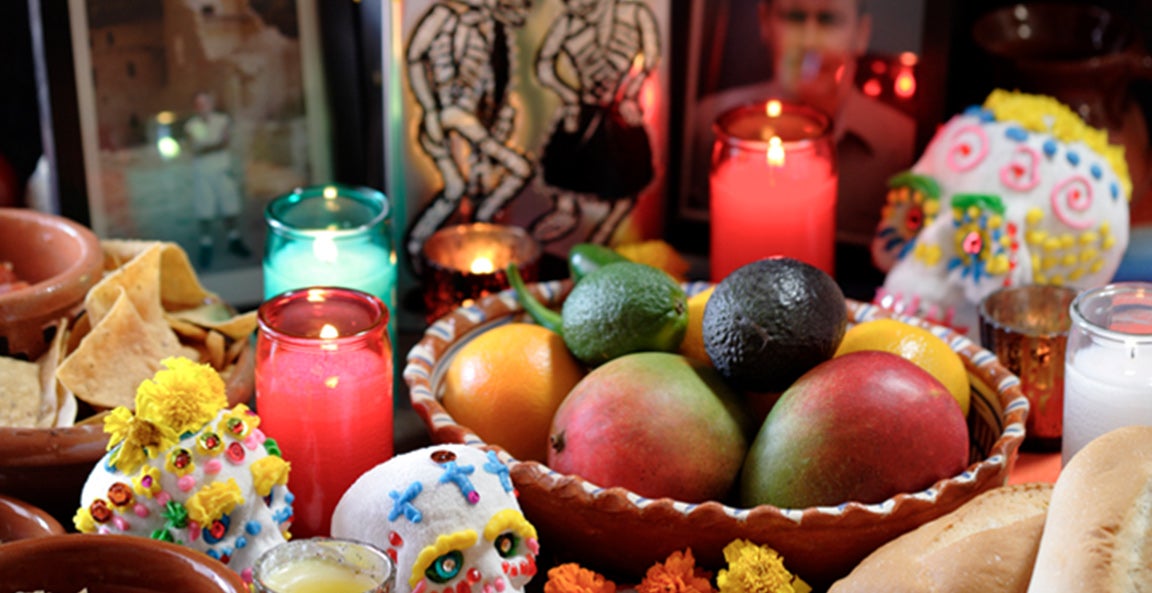- Signature Collections
- More Ways to Shop
 Delphinium >
Delphinium >
- Occasions
- Lifestyle
 Money Tree >
Money Tree >
- Keepsakes & Personalized
 Chocolate Covered Strawberries >
Chocolate Covered Strawberries >
Don't have an account?
Click Here
Our relationship with food is almost as complicated as the one we have with death. Food can bring comfort, be tied to feelings of guilt or pleasure, and can evoke memories and feelings as powerful as any song. It’s no wonder that throughout history and across cultures, people have used food to help honor loved ones who have died. Here are some ways in which it’s been done.
1. Dumb Supper
During this feast — thought by some scholars to be a precursor to modern Halloween — a table is laid out all in black, with places for both the living and the dead. No one speaks to allow for communion with the dead. Guests bring with them a letter written to a loved one who has passed. When the meal is over the unread letters are burned and one by one the messages within are thought to be carried into the spirit world. Believed to have roots in ancient Celtic tradition, the dumb supper was brought to Appalachia by American settlers. Some living in the region still hold the suppers. It is also observed on Samhain, one of the four Gaelic seasonal festivals, by Pagans and Wiccans.
2. Telling the Bees
One old English custom also practiced in America in the early 19th century — and a risky one, to be sure — involved going out to the beehive to deliver the news that a family member had died. The messenger would tap on the hive and whisper, “Little Brownies, your mistress is dead.” Families would attach an invitation to the funeral on the hive and bring food from the funeral feast to the bees. This was a way to show gratitude and respect for the bees and their gifts of honey, beeswax and pollination. Fail to do so, and you would risk offending the bees, which might choose to move on to a more appreciative family.
3. Fave dei Morti (Beans of the Dead)
During ancient Roman times, the souls of ancestors were thought to reside in fava beans. At Roman wedding feasts, beans were presented to the bride and groom, who would eat them in hopes of attracting the souls of male ancestors to carry on the family bloodline. (Eating beans on your wedding day — that’s risky in a different way.) As a bonus, beans were also believed to ward off ghosts and vampires, who were easily tricked into thinking the beans were living people. And on All Souls Day in Italy, it is common to consume bean-shaped cookies, or fave del morti. There are many different variations, but the most popular resembles a macaroon-like cake in appearance, but with a rich, buttery texture and sweet almond flavor. More traditional versions are shaped like kidney beans and flavored with almond flour and extract. Here’s a recipe.
4. Obon Figures
Obon is a series of festival days in Japan when the souls of the departed are thought to visit their living relatives. Horses and cow figurines are made from vegetables placed on altars. It is believed that the spirits of the visiting ancestors ride the animals between worlds of the living and the dead.
5. Funeral Biscuits
Funeral biscuits first appeared in 1600s Europe, and were also commonplace up until the early 1900s in America. They were sometimes taken door-to-door and served as a funeral invitation or handed out as a keepsake after the funeral. According to Barts Pathology Museum’s curator Carla Valentine, funeral biscuits were wrapped in a paper that bore a poem or prayer with the name of the deceased, then sealed with black wax and stamped with a skull or hourglass. Should you want to make a batch, here’s a recipe.
6. Lemons
In Switzerland, male mourners would wrap a lemon in a handkerchief and place it into their hat. The hat would be carried under the left arm for the duration of the funeral. At the end of the service, the lemons were placed on the grave to symbolize the “sharpness” of their grief.
7. Los Angelitos
During Mexico’s Days of the Dead, a sacred observance when spirits of deceased family members are believed to return to the earth for a family reunion with the living, one day is set aside to welcome the spirits of children, or Los Angelitos (The Little Angels). Altars are decorated, and food is offered up in miniature portions and served on tiny plates, often with a little glass of milk.
8. Journey Cakes
A staple of cuisine in the American south is a little corn cake, known as a Johnny Cake. The term “Johnny” was derived from the corn cakes’ original use as “Journey Cakes,” among some African tribes. They were placed in coffins to provide sustenance for the deceased during their long journey to the afterlife.
9. Parsley
After ancient Greeks dedicated this herb to the goddess Persephone, who reigns over the land of the dead, it became a staple during funeral rites. Parsley was planted over graves and athletes donned crowns of parsley during Funeral Games. The games, depicted in the Iliad, were played in the deceased’s honor and are recognized as the precursor to the Olympics. They included chariot races, wrestling, boxing, discus throwing and running.
10. Cemetery Picnics
During the Victorian era when cemeteries were cultivated as parks and gardens, people came to enjoy a day of leisure, to partake of a meal with loved ones no longer with them or even dine on the family’s prepaid plot. In America, the practice took on a more practical purpose: when communities would come together to help clean and maintain the cemetery grounds. Graves would be tended to, trees and flowers planted, and repairs made. Once the work was done, families would set out their potluck dishes and share in a communal meal.
A version of this piece originally ran on modernloss.com.